Corporate Social Responsibility and Financial Distress Analysis
VerifiedAdded on 2022/09/08
|30
|15416
|23
Report
AI Summary
This study, published on Desklib, investigates the association between corporate social responsibility (CSR) performance and financial distress in publicly listed Australian firms from 2007 to 2013. The research employs regression analysis to demonstrate a significant negative relationship between positive CSR activities and financial distress, indicating that firms with strong CSR practices experience reduced financial distress. The study also examines the moderating effect of firm life cycle stages on this relationship, revealing that the negative association between CSR and financial distress is more pronounced in firms in mature life cycle stages. The findings, based on a sample of 651 firm-years, are robust to alternative measures of financial distress, CSR performance, and life cycle stages, contributing to the understanding of financial distress drivers and the economic consequences of CSR engagement. The study highlights CSR as a risk management strategy, emphasizing its role in preserving corporate financial performance and its implications for stakeholder relationships. This research provides valuable insights for investors and firms regarding the importance of CSR in financial risk management, particularly in the context of Australian listed firms.
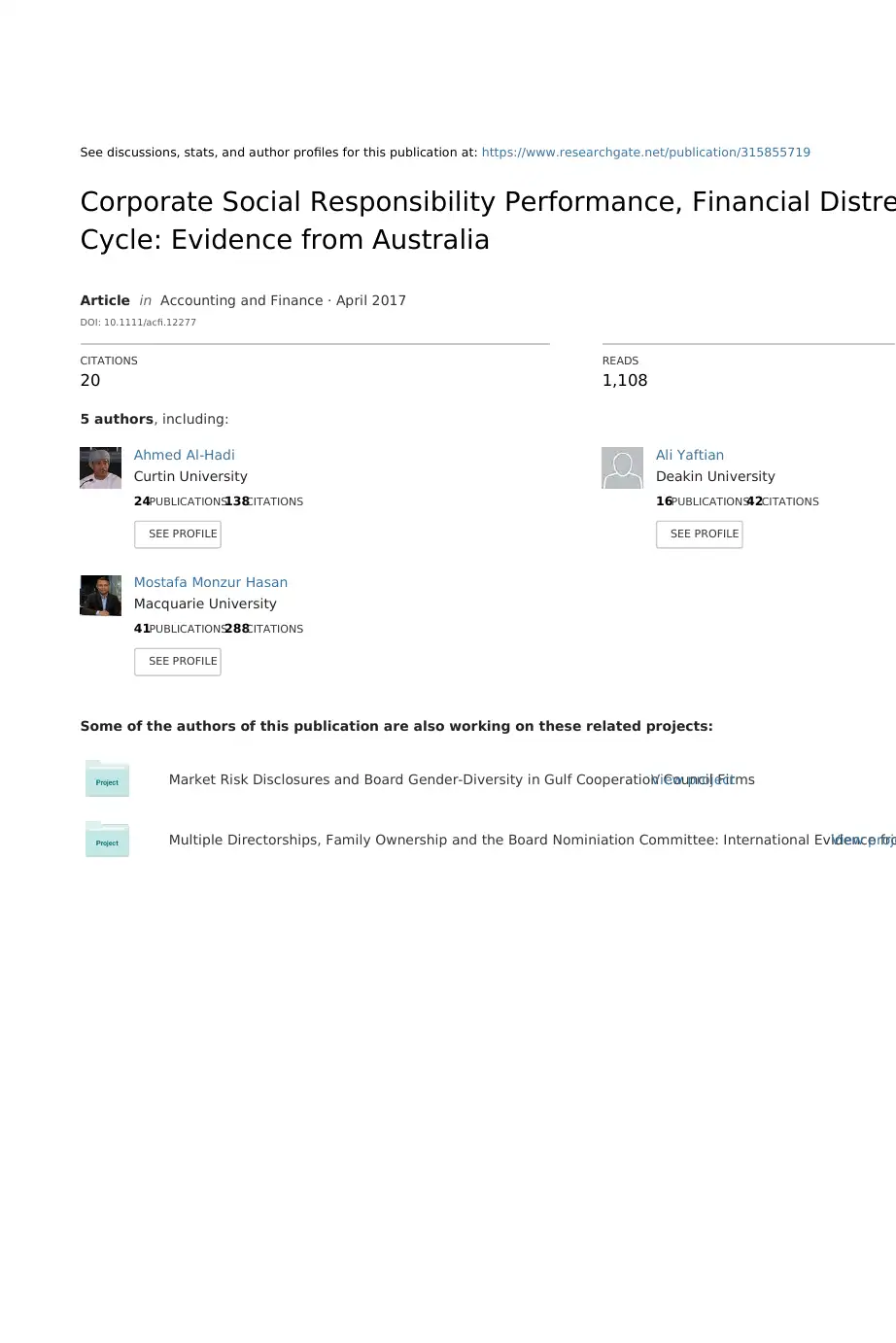
See discussions, stats, and author profiles for this publication at: https://www.researchgate.net/publication/315855719
Corporate Social Responsibility Performance, Financial Distre
Cycle: Evidence from Australia
Article in Accounting and Finance · April 2017
DOI: 10.1111/acfi.12277
CITATIONS
20
READS
1,108
5 authors, including:
Some of the authors of this publication are also working on these related projects:
Market Risk Disclosures and Board Gender-Diversity in Gulf Cooperation Council FirmsView project
Multiple Directorships, Family Ownership and the Board Nominiation Committee: International Evidence froView proje
Ahmed Al‐Hadi
Curtin University
24PUBLICATIONS138CITATIONS
SEE PROFILE
Ali Yaftian
Deakin University
16PUBLICATIONS42CITATIONS
SEE PROFILE
Mostafa Monzur Hasan
Macquarie University
41PUBLICATIONS288CITATIONS
SEE PROFILE
Corporate Social Responsibility Performance, Financial Distre
Cycle: Evidence from Australia
Article in Accounting and Finance · April 2017
DOI: 10.1111/acfi.12277
CITATIONS
20
READS
1,108
5 authors, including:
Some of the authors of this publication are also working on these related projects:
Market Risk Disclosures and Board Gender-Diversity in Gulf Cooperation Council FirmsView project
Multiple Directorships, Family Ownership and the Board Nominiation Committee: International Evidence froView proje
Ahmed Al‐Hadi
Curtin University
24PUBLICATIONS138CITATIONS
SEE PROFILE
Ali Yaftian
Deakin University
16PUBLICATIONS42CITATIONS
SEE PROFILE
Mostafa Monzur Hasan
Macquarie University
41PUBLICATIONS288CITATIONS
SEE PROFILE
Paraphrase This Document
Need a fresh take? Get an instant paraphrase of this document with our AI Paraphraser
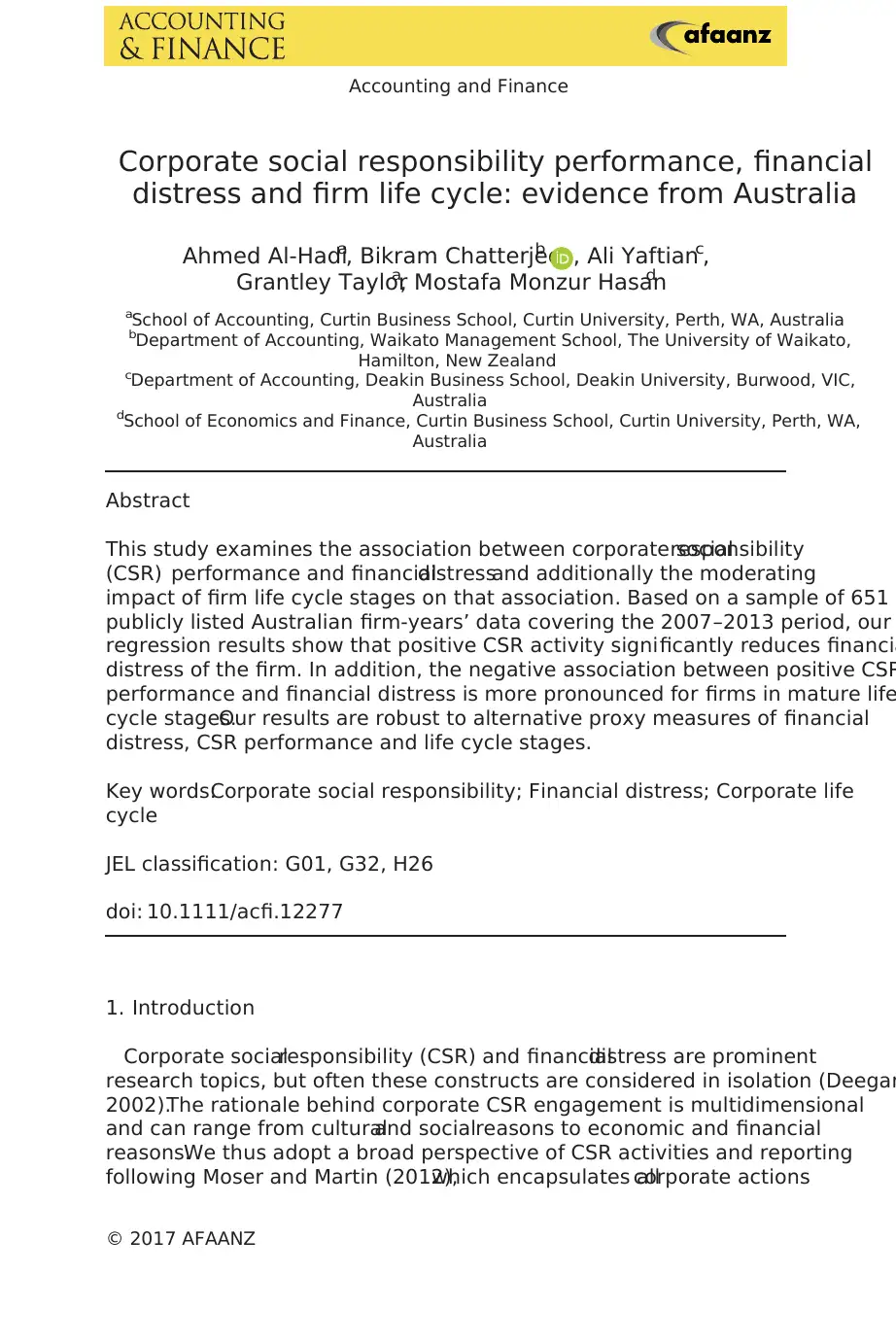
Corporate social responsibility performance, financial
distress and firm life cycle: evidence from Australia
Ahmed Al-Hadia, Bikram Chatterjeeb , Ali Yaftianc,
Grantley Taylora, Mostafa Monzur Hasand
aSchool of Accounting, Curtin Business School, Curtin University, Perth, WA, Australia
bDepartment of Accounting, Waikato Management School, The University of Waikato,
Hamilton, New Zealand
cDepartment of Accounting, Deakin Business School, Deakin University, Burwood, VIC,
Australia
dSchool of Economics and Finance, Curtin Business School, Curtin University, Perth, WA,
Australia
Abstract
This study examines the association between corporate socialresponsibility
(CSR) performance and financialdistressand additionally the moderating
impact of firm life cycle stages on that association. Based on a sample of 651
publicly listed Australian firm-years’ data covering the 2007–2013 period, our
regression results show that positive CSR activity significantly reduces financia
distress of the firm. In addition, the negative association between positive CSR
performance and financial distress is more pronounced for firms in mature life
cycle stages.Our results are robust to alternative proxy measures of financial
distress, CSR performance and life cycle stages.
Key words:Corporate social responsibility; Financial distress; Corporate life
cycle
JEL classification: G01, G32, H26
doi: 10.1111/acfi.12277
1. Introduction
Corporate socialresponsibility (CSR) and financialdistress are prominent
research topics, but often these constructs are considered in isolation (Deegan
2002).The rationale behind corporate CSR engagement is multidimensional
and can range from culturaland socialreasons to economic and financial
reasons.We thus adopt a broad perspective of CSR activities and reporting
following Moser and Martin (2012),which encapsulates allcorporate actions
© 2017 AFAANZ
Accounting and Finance
distress and firm life cycle: evidence from Australia
Ahmed Al-Hadia, Bikram Chatterjeeb , Ali Yaftianc,
Grantley Taylora, Mostafa Monzur Hasand
aSchool of Accounting, Curtin Business School, Curtin University, Perth, WA, Australia
bDepartment of Accounting, Waikato Management School, The University of Waikato,
Hamilton, New Zealand
cDepartment of Accounting, Deakin Business School, Deakin University, Burwood, VIC,
Australia
dSchool of Economics and Finance, Curtin Business School, Curtin University, Perth, WA,
Australia
Abstract
This study examines the association between corporate socialresponsibility
(CSR) performance and financialdistressand additionally the moderating
impact of firm life cycle stages on that association. Based on a sample of 651
publicly listed Australian firm-years’ data covering the 2007–2013 period, our
regression results show that positive CSR activity significantly reduces financia
distress of the firm. In addition, the negative association between positive CSR
performance and financial distress is more pronounced for firms in mature life
cycle stages.Our results are robust to alternative proxy measures of financial
distress, CSR performance and life cycle stages.
Key words:Corporate social responsibility; Financial distress; Corporate life
cycle
JEL classification: G01, G32, H26
doi: 10.1111/acfi.12277
1. Introduction
Corporate socialresponsibility (CSR) and financialdistress are prominent
research topics, but often these constructs are considered in isolation (Deegan
2002).The rationale behind corporate CSR engagement is multidimensional
and can range from culturaland socialreasons to economic and financial
reasons.We thus adopt a broad perspective of CSR activities and reporting
following Moser and Martin (2012),which encapsulates allcorporate actions
© 2017 AFAANZ
Accounting and Finance
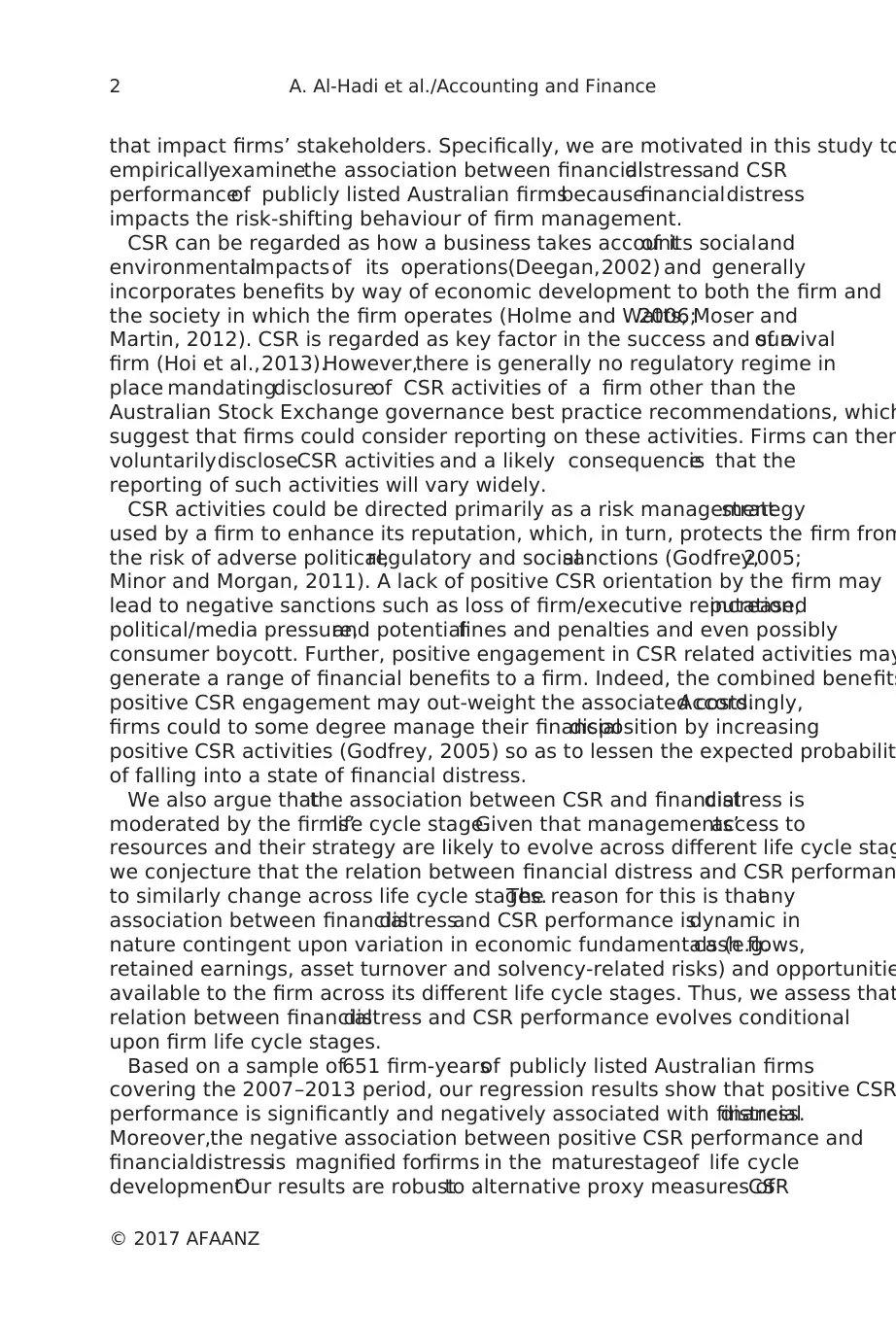
that impact firms’ stakeholders. Specifically, we are motivated in this study to
empiricallyexaminethe association between financialdistressand CSR
performanceof publicly listed Australian firmsbecausefinancialdistress
impacts the risk-shifting behaviour of firm management.
CSR can be regarded as how a business takes accountof its socialand
environmentalimpacts of its operations(Deegan,2002) and generally
incorporates benefits by way of economic development to both the firm and
the society in which the firm operates (Holme and Watts,2006;Moser and
Martin, 2012). CSR is regarded as key factor in the success and survivalof a
firm (Hoi et al.,2013).However,there is generally no regulatory regime in
place mandatingdisclosureof CSR activities of a firm other than the
Australian Stock Exchange governance best practice recommendations, which
suggest that firms could consider reporting on these activities. Firms can then
voluntarilydiscloseCSR activities and a likely consequenceis that the
reporting of such activities will vary widely.
CSR activities could be directed primarily as a risk managementstrategy
used by a firm to enhance its reputation, which, in turn, protects the firm from
the risk of adverse political,regulatory and socialsanctions (Godfrey,2005;
Minor and Morgan, 2011). A lack of positive CSR orientation by the firm may
lead to negative sanctions such as loss of firm/executive reputation,increased
political/media pressure,and potentialfines and penalties and even possibly
consumer boycott. Further, positive engagement in CSR related activities may
generate a range of financial benefits to a firm. Indeed, the combined benefits
positive CSR engagement may out-weight the associated costs.Accordingly,
firms could to some degree manage their financialdisposition by increasing
positive CSR activities (Godfrey, 2005) so as to lessen the expected probabilit
of falling into a state of financial distress.
We also argue thatthe association between CSR and financialdistress is
moderated by the firms’life cycle stage.Given that managements’access to
resources and their strategy are likely to evolve across different life cycle stag
we conjecture that the relation between financial distress and CSR performan
to similarly change across life cycle stages.The reason for this is thatany
association between financialdistressand CSR performance isdynamic in
nature contingent upon variation in economic fundamentals (e.g.cash flows,
retained earnings, asset turnover and solvency-related risks) and opportunitie
available to the firm across its different life cycle stages. Thus, we assess that
relation between financialdistress and CSR performance evolves conditional
upon firm life cycle stages.
Based on a sample of651 firm-yearsof publicly listed Australian firms
covering the 2007–2013 period, our regression results show that positive CSR
performance is significantly and negatively associated with financialdistress.
Moreover,the negative association between positive CSR performance and
financialdistressis magnified forfirms in the maturestageof life cycle
development.Our results are robustto alternative proxy measures ofCSR
© 2017 AFAANZ
2 A. Al-Hadi et al./Accounting and Finance
empiricallyexaminethe association between financialdistressand CSR
performanceof publicly listed Australian firmsbecausefinancialdistress
impacts the risk-shifting behaviour of firm management.
CSR can be regarded as how a business takes accountof its socialand
environmentalimpacts of its operations(Deegan,2002) and generally
incorporates benefits by way of economic development to both the firm and
the society in which the firm operates (Holme and Watts,2006;Moser and
Martin, 2012). CSR is regarded as key factor in the success and survivalof a
firm (Hoi et al.,2013).However,there is generally no regulatory regime in
place mandatingdisclosureof CSR activities of a firm other than the
Australian Stock Exchange governance best practice recommendations, which
suggest that firms could consider reporting on these activities. Firms can then
voluntarilydiscloseCSR activities and a likely consequenceis that the
reporting of such activities will vary widely.
CSR activities could be directed primarily as a risk managementstrategy
used by a firm to enhance its reputation, which, in turn, protects the firm from
the risk of adverse political,regulatory and socialsanctions (Godfrey,2005;
Minor and Morgan, 2011). A lack of positive CSR orientation by the firm may
lead to negative sanctions such as loss of firm/executive reputation,increased
political/media pressure,and potentialfines and penalties and even possibly
consumer boycott. Further, positive engagement in CSR related activities may
generate a range of financial benefits to a firm. Indeed, the combined benefits
positive CSR engagement may out-weight the associated costs.Accordingly,
firms could to some degree manage their financialdisposition by increasing
positive CSR activities (Godfrey, 2005) so as to lessen the expected probabilit
of falling into a state of financial distress.
We also argue thatthe association between CSR and financialdistress is
moderated by the firms’life cycle stage.Given that managements’access to
resources and their strategy are likely to evolve across different life cycle stag
we conjecture that the relation between financial distress and CSR performan
to similarly change across life cycle stages.The reason for this is thatany
association between financialdistressand CSR performance isdynamic in
nature contingent upon variation in economic fundamentals (e.g.cash flows,
retained earnings, asset turnover and solvency-related risks) and opportunitie
available to the firm across its different life cycle stages. Thus, we assess that
relation between financialdistress and CSR performance evolves conditional
upon firm life cycle stages.
Based on a sample of651 firm-yearsof publicly listed Australian firms
covering the 2007–2013 period, our regression results show that positive CSR
performance is significantly and negatively associated with financialdistress.
Moreover,the negative association between positive CSR performance and
financialdistressis magnified forfirms in the maturestageof life cycle
development.Our results are robustto alternative proxy measures ofCSR
© 2017 AFAANZ
2 A. Al-Hadi et al./Accounting and Finance
⊘ This is a preview!⊘
Do you want full access?
Subscribe today to unlock all pages.

Trusted by 1+ million students worldwide
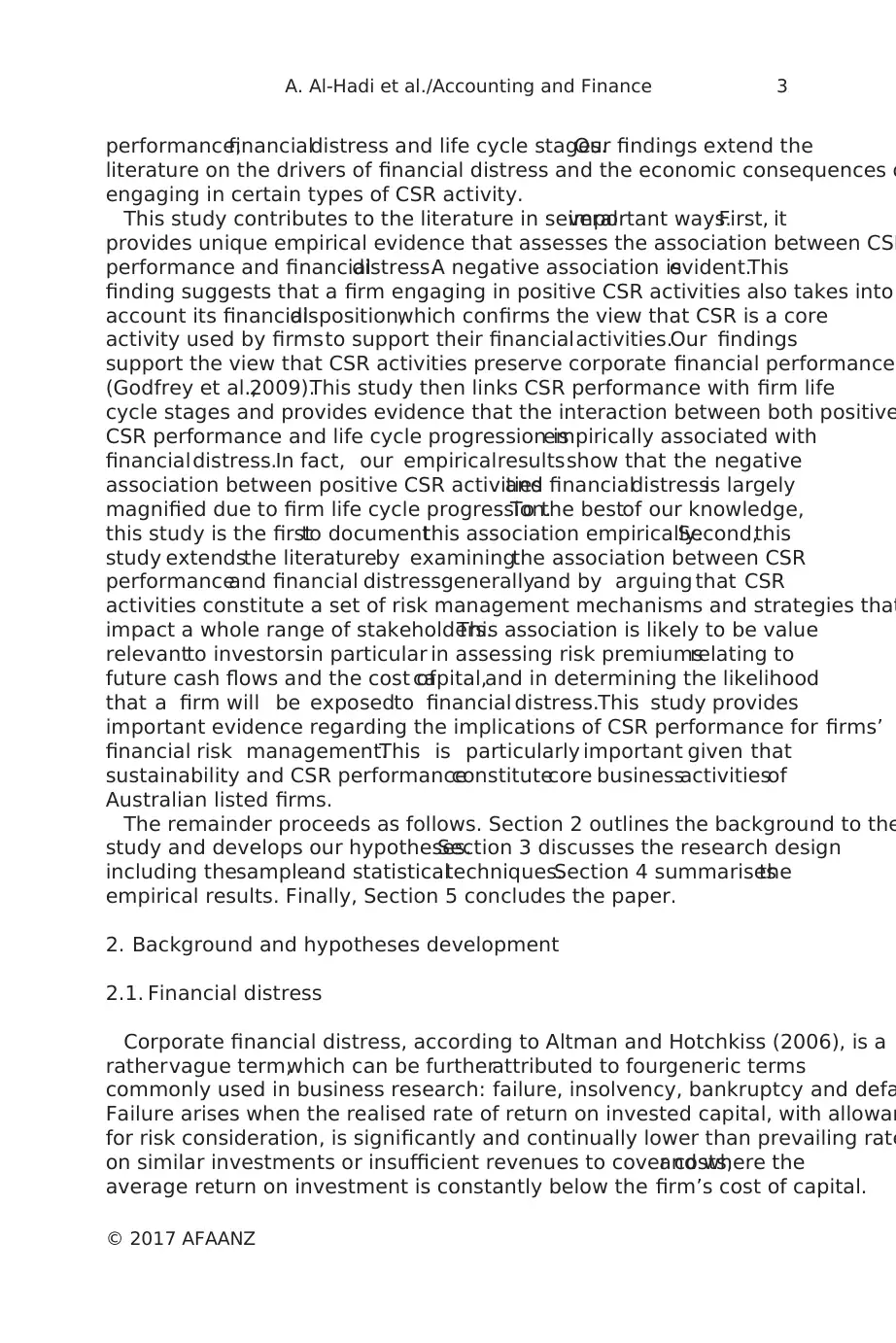
performance,financialdistress and life cycle stages.Our findings extend the
literature on the drivers of financial distress and the economic consequences o
engaging in certain types of CSR activity.
This study contributes to the literature in severalimportant ways.First, it
provides unique empirical evidence that assesses the association between CSR
performance and financialdistress.A negative association isevident.This
finding suggests that a firm engaging in positive CSR activities also takes into
account its financialdisposition,which confirms the view that CSR is a core
activity used by firmsto support their financialactivities.Our findings
support the view that CSR activities preserve corporate financial performance
(Godfrey et al.,2009).This study then links CSR performance with firm life
cycle stages and provides evidence that the interaction between both positive
CSR performance and life cycle progression isempirically associated with
financialdistress.In fact, our empiricalresultsshow that the negative
association between positive CSR activitiesand financialdistressis largely
magnified due to firm life cycle progression.To the bestof our knowledge,
this study is the firstto documentthis association empirically.Second,this
study extendsthe literatureby examiningthe association between CSR
performanceand financial distressgenerallyand by arguing that CSR
activities constitute a set of risk management mechanisms and strategies that
impact a whole range of stakeholders.This association is likely to be value
relevantto investorsin particular in assessing risk premiumsrelating to
future cash flows and the cost ofcapital,and in determining the likelihood
that a firm will be exposedto financial distress.This study provides
important evidence regarding the implications of CSR performance for firms’
financial risk management.This is particularly important given that
sustainability and CSR performanceconstitutecore businessactivitiesof
Australian listed firms.
The remainder proceeds as follows. Section 2 outlines the background to the
study and develops our hypotheses.Section 3 discusses the research design
including thesampleand statisticaltechniques.Section 4 summarisesthe
empirical results. Finally, Section 5 concludes the paper.
2. Background and hypotheses development
2.1. Financial distress
Corporate financial distress, according to Altman and Hotchkiss (2006), is a
rathervague term,which can be furtherattributed to fourgeneric terms
commonly used in business research: failure, insolvency, bankruptcy and defa
Failure arises when the realised rate of return on invested capital, with allowan
for risk consideration, is significantly and continually lower than prevailing rate
on similar investments or insufficient revenues to cover costs,and where the
average return on investment is constantly below the firm’s cost of capital.
© 2017 AFAANZ
A. Al-Hadi et al./Accounting and Finance 3
literature on the drivers of financial distress and the economic consequences o
engaging in certain types of CSR activity.
This study contributes to the literature in severalimportant ways.First, it
provides unique empirical evidence that assesses the association between CSR
performance and financialdistress.A negative association isevident.This
finding suggests that a firm engaging in positive CSR activities also takes into
account its financialdisposition,which confirms the view that CSR is a core
activity used by firmsto support their financialactivities.Our findings
support the view that CSR activities preserve corporate financial performance
(Godfrey et al.,2009).This study then links CSR performance with firm life
cycle stages and provides evidence that the interaction between both positive
CSR performance and life cycle progression isempirically associated with
financialdistress.In fact, our empiricalresultsshow that the negative
association between positive CSR activitiesand financialdistressis largely
magnified due to firm life cycle progression.To the bestof our knowledge,
this study is the firstto documentthis association empirically.Second,this
study extendsthe literatureby examiningthe association between CSR
performanceand financial distressgenerallyand by arguing that CSR
activities constitute a set of risk management mechanisms and strategies that
impact a whole range of stakeholders.This association is likely to be value
relevantto investorsin particular in assessing risk premiumsrelating to
future cash flows and the cost ofcapital,and in determining the likelihood
that a firm will be exposedto financial distress.This study provides
important evidence regarding the implications of CSR performance for firms’
financial risk management.This is particularly important given that
sustainability and CSR performanceconstitutecore businessactivitiesof
Australian listed firms.
The remainder proceeds as follows. Section 2 outlines the background to the
study and develops our hypotheses.Section 3 discusses the research design
including thesampleand statisticaltechniques.Section 4 summarisesthe
empirical results. Finally, Section 5 concludes the paper.
2. Background and hypotheses development
2.1. Financial distress
Corporate financial distress, according to Altman and Hotchkiss (2006), is a
rathervague term,which can be furtherattributed to fourgeneric terms
commonly used in business research: failure, insolvency, bankruptcy and defa
Failure arises when the realised rate of return on invested capital, with allowan
for risk consideration, is significantly and continually lower than prevailing rate
on similar investments or insufficient revenues to cover costs,and where the
average return on investment is constantly below the firm’s cost of capital.
© 2017 AFAANZ
A. Al-Hadi et al./Accounting and Finance 3
Paraphrase This Document
Need a fresh take? Get an instant paraphrase of this document with our AI Paraphraser
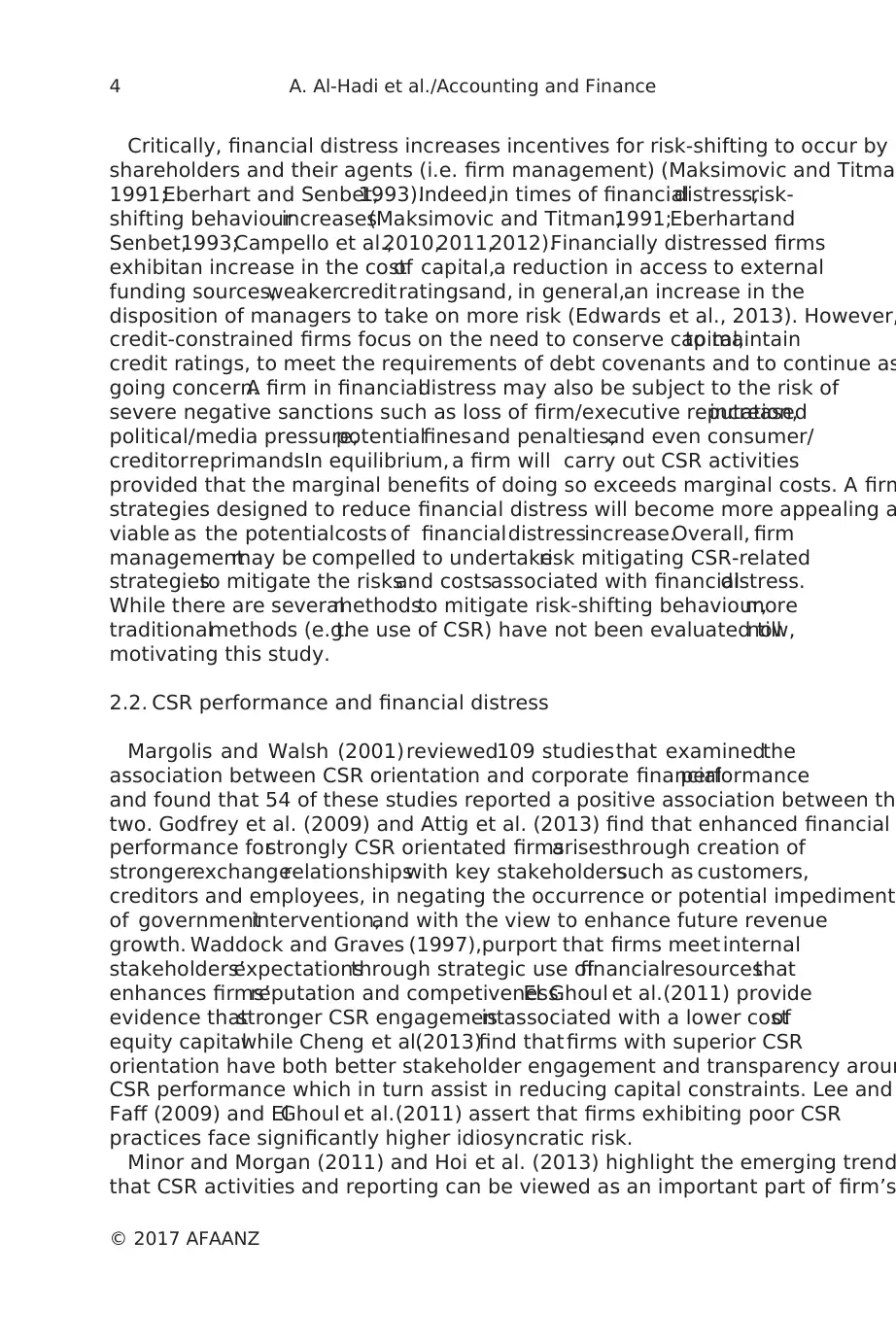
Critically, financial distress increases incentives for risk-shifting to occur by
shareholders and their agents (i.e. firm management) (Maksimovic and Titma
1991;Eberhart and Senbet,1993).Indeed,in times of financialdistress,risk-
shifting behaviourincreases(Maksimovic and Titman,1991;Eberhartand
Senbet,1993;Campello et al.,2010,2011,2012).Financially distressed firms
exhibitan increase in the costof capital,a reduction in access to external
funding sources,weakercreditratingsand, in general,an increase in the
disposition of managers to take on more risk (Edwards et al., 2013). However,
credit-constrained firms focus on the need to conserve capital,to maintain
credit ratings, to meet the requirements of debt covenants and to continue as
going concern.A firm in financialdistress may also be subject to the risk of
severe negative sanctions such as loss of firm/executive reputation,increased
political/media pressure,potentialfinesand penalties,and even consumer/
creditorreprimands.In equilibrium, a firm will carry out CSR activities
provided that the marginal benefits of doing so exceeds marginal costs. A firm
strategies designed to reduce financial distress will become more appealing a
viable as the potentialcosts of financialdistressincrease.Overall, firm
managementmay be compelled to undertakerisk mitigating CSR-related
strategiesto mitigate the risksand costsassociated with financialdistress.
While there are severalmethodsto mitigate risk-shifting behaviour,more
traditionalmethods (e.g.the use of CSR) have not been evaluated tillnow,
motivating this study.
2.2. CSR performance and financial distress
Margolis and Walsh (2001)reviewed109 studiesthat examinedthe
association between CSR orientation and corporate financialperformance
and found that 54 of these studies reported a positive association between th
two. Godfrey et al. (2009) and Attig et al. (2013) find that enhanced financial
performance forstrongly CSR orientated firmsarisesthrough creation of
strongerexchangerelationshipswith key stakeholderssuch as customers,
creditors and employees, in negating the occurrence or potential impediment
of governmentintervention,and with the view to enhance future revenue
growth. Waddock and Graves (1997),purport that firms meet internal
stakeholders’expectationsthrough strategic use offinancialresourcesthat
enhances firms’reputation and competiveness.El Ghoul et al.(2011) provide
evidence thatstronger CSR engagementis associated with a lower costof
equity capitalwhile Cheng et al.(2013)find that firms with superior CSR
orientation have both better stakeholder engagement and transparency aroun
CSR performance which in turn assist in reducing capital constraints. Lee and
Faff (2009) and ElGhoul et al.(2011) assert that firms exhibiting poor CSR
practices face significantly higher idiosyncratic risk.
Minor and Morgan (2011) and Hoi et al. (2013) highlight the emerging trend
that CSR activities and reporting can be viewed as an important part of firm’s
© 2017 AFAANZ
4 A. Al-Hadi et al./Accounting and Finance
shareholders and their agents (i.e. firm management) (Maksimovic and Titma
1991;Eberhart and Senbet,1993).Indeed,in times of financialdistress,risk-
shifting behaviourincreases(Maksimovic and Titman,1991;Eberhartand
Senbet,1993;Campello et al.,2010,2011,2012).Financially distressed firms
exhibitan increase in the costof capital,a reduction in access to external
funding sources,weakercreditratingsand, in general,an increase in the
disposition of managers to take on more risk (Edwards et al., 2013). However,
credit-constrained firms focus on the need to conserve capital,to maintain
credit ratings, to meet the requirements of debt covenants and to continue as
going concern.A firm in financialdistress may also be subject to the risk of
severe negative sanctions such as loss of firm/executive reputation,increased
political/media pressure,potentialfinesand penalties,and even consumer/
creditorreprimands.In equilibrium, a firm will carry out CSR activities
provided that the marginal benefits of doing so exceeds marginal costs. A firm
strategies designed to reduce financial distress will become more appealing a
viable as the potentialcosts of financialdistressincrease.Overall, firm
managementmay be compelled to undertakerisk mitigating CSR-related
strategiesto mitigate the risksand costsassociated with financialdistress.
While there are severalmethodsto mitigate risk-shifting behaviour,more
traditionalmethods (e.g.the use of CSR) have not been evaluated tillnow,
motivating this study.
2.2. CSR performance and financial distress
Margolis and Walsh (2001)reviewed109 studiesthat examinedthe
association between CSR orientation and corporate financialperformance
and found that 54 of these studies reported a positive association between th
two. Godfrey et al. (2009) and Attig et al. (2013) find that enhanced financial
performance forstrongly CSR orientated firmsarisesthrough creation of
strongerexchangerelationshipswith key stakeholderssuch as customers,
creditors and employees, in negating the occurrence or potential impediment
of governmentintervention,and with the view to enhance future revenue
growth. Waddock and Graves (1997),purport that firms meet internal
stakeholders’expectationsthrough strategic use offinancialresourcesthat
enhances firms’reputation and competiveness.El Ghoul et al.(2011) provide
evidence thatstronger CSR engagementis associated with a lower costof
equity capitalwhile Cheng et al.(2013)find that firms with superior CSR
orientation have both better stakeholder engagement and transparency aroun
CSR performance which in turn assist in reducing capital constraints. Lee and
Faff (2009) and ElGhoul et al.(2011) assert that firms exhibiting poor CSR
practices face significantly higher idiosyncratic risk.
Minor and Morgan (2011) and Hoi et al. (2013) highlight the emerging trend
that CSR activities and reporting can be viewed as an important part of firm’s
© 2017 AFAANZ
4 A. Al-Hadi et al./Accounting and Finance
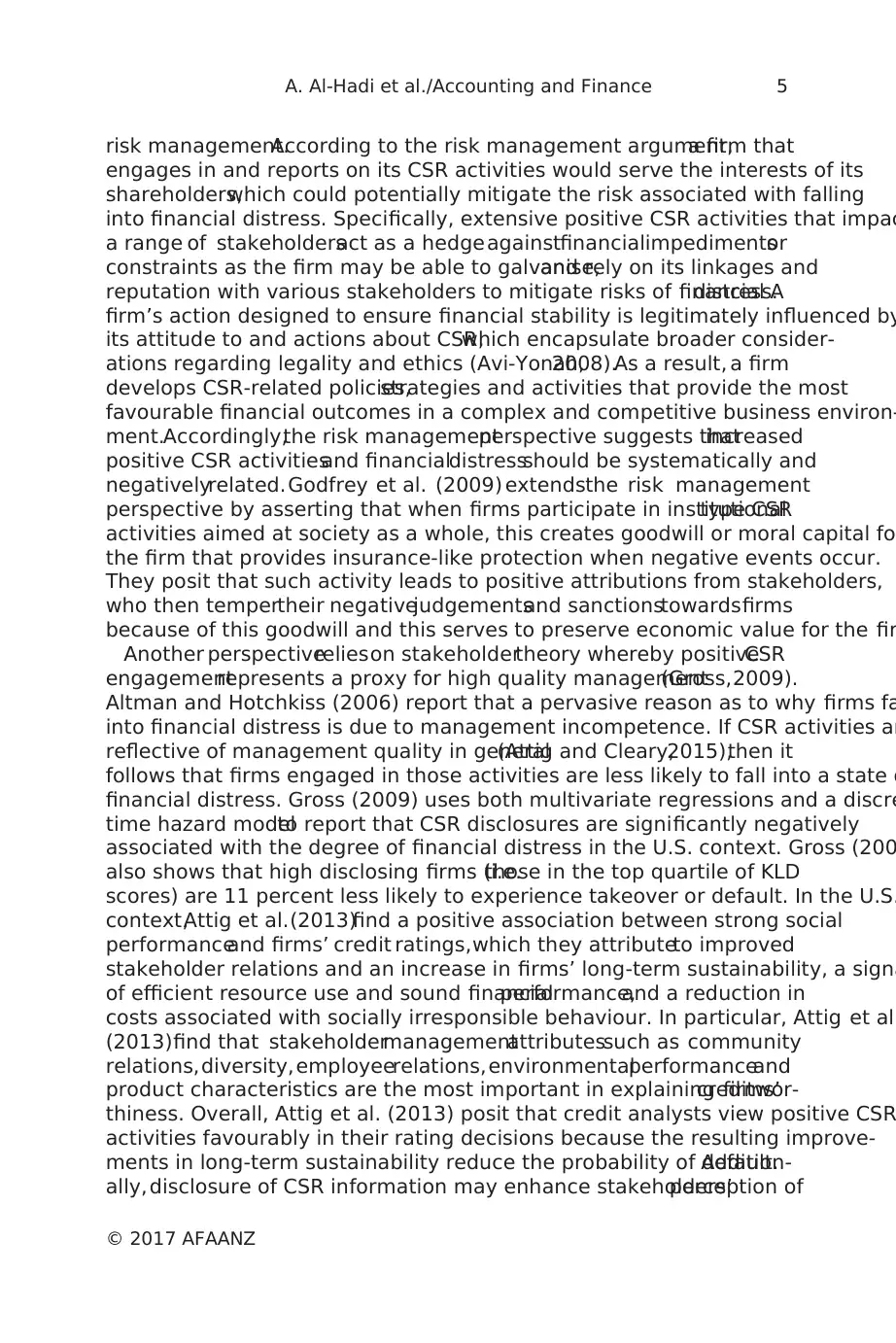
risk management.According to the risk management argument,a firm that
engages in and reports on its CSR activities would serve the interests of its
shareholders,which could potentially mitigate the risk associated with falling
into financial distress. Specifically, extensive positive CSR activities that impac
a range of stakeholdersact as a hedgeagainstfinancialimpedimentsor
constraints as the firm may be able to galvanise,and rely on its linkages and
reputation with various stakeholders to mitigate risks of financialdistress.A
firm’s action designed to ensure financial stability is legitimately influenced by
its attitude to and actions about CSR,which encapsulate broader consider-
ations regarding legality and ethics (Avi-Yonah,2008).As a result, a firm
develops CSR-related policies,strategies and activities that provide the most
favourable financial outcomes in a complex and competitive business environ-
ment.Accordingly,the risk managementperspective suggests thatincreased
positive CSR activitiesand financialdistressshould be systematically and
negativelyrelated.Godfrey et al. (2009) extendsthe risk management
perspective by asserting that when firms participate in institutionaltype CSR
activities aimed at society as a whole, this creates goodwill or moral capital fo
the firm that provides insurance-like protection when negative events occur.
They posit that such activity leads to positive attributions from stakeholders,
who then tempertheir negativejudgementsand sanctionstowardsfirms
because of this goodwill and this serves to preserve economic value for the fir
Another perspectiverelieson stakeholdertheory whereby positiveCSR
engagementrepresents a proxy for high quality management(Gross,2009).
Altman and Hotchkiss (2006) report that a pervasive reason as to why firms fa
into financial distress is due to management incompetence. If CSR activities ar
reflective of management quality in general(Attig and Cleary,2015),then it
follows that firms engaged in those activities are less likely to fall into a state o
financial distress. Gross (2009) uses both multivariate regressions and a discre
time hazard modelto report that CSR disclosures are significantly negatively
associated with the degree of financial distress in the U.S. context. Gross (200
also shows that high disclosing firms (i.e.those in the top quartile of KLD
scores) are 11 percent less likely to experience takeover or default. In the U.S.
context,Attig et al.(2013)find a positive association between strong social
performanceand firms’ credit ratings,which they attributeto improved
stakeholder relations and an increase in firms’ long-term sustainability, a signa
of efficient resource use and sound financialperformance,and a reduction in
costs associated with socially irresponsible behaviour. In particular, Attig et al.
(2013)find that stakeholdermanagementattributessuch as community
relations,diversity,employeerelations,environmentalperformanceand
product characteristics are the most important in explaining firms’creditwor-
thiness. Overall, Attig et al. (2013) posit that credit analysts view positive CSR
activities favourably in their rating decisions because the resulting improve-
ments in long-term sustainability reduce the probability of default.Addition-
ally, disclosure of CSR information may enhance stakeholders’perception of
© 2017 AFAANZ
A. Al-Hadi et al./Accounting and Finance 5
engages in and reports on its CSR activities would serve the interests of its
shareholders,which could potentially mitigate the risk associated with falling
into financial distress. Specifically, extensive positive CSR activities that impac
a range of stakeholdersact as a hedgeagainstfinancialimpedimentsor
constraints as the firm may be able to galvanise,and rely on its linkages and
reputation with various stakeholders to mitigate risks of financialdistress.A
firm’s action designed to ensure financial stability is legitimately influenced by
its attitude to and actions about CSR,which encapsulate broader consider-
ations regarding legality and ethics (Avi-Yonah,2008).As a result, a firm
develops CSR-related policies,strategies and activities that provide the most
favourable financial outcomes in a complex and competitive business environ-
ment.Accordingly,the risk managementperspective suggests thatincreased
positive CSR activitiesand financialdistressshould be systematically and
negativelyrelated.Godfrey et al. (2009) extendsthe risk management
perspective by asserting that when firms participate in institutionaltype CSR
activities aimed at society as a whole, this creates goodwill or moral capital fo
the firm that provides insurance-like protection when negative events occur.
They posit that such activity leads to positive attributions from stakeholders,
who then tempertheir negativejudgementsand sanctionstowardsfirms
because of this goodwill and this serves to preserve economic value for the fir
Another perspectiverelieson stakeholdertheory whereby positiveCSR
engagementrepresents a proxy for high quality management(Gross,2009).
Altman and Hotchkiss (2006) report that a pervasive reason as to why firms fa
into financial distress is due to management incompetence. If CSR activities ar
reflective of management quality in general(Attig and Cleary,2015),then it
follows that firms engaged in those activities are less likely to fall into a state o
financial distress. Gross (2009) uses both multivariate regressions and a discre
time hazard modelto report that CSR disclosures are significantly negatively
associated with the degree of financial distress in the U.S. context. Gross (200
also shows that high disclosing firms (i.e.those in the top quartile of KLD
scores) are 11 percent less likely to experience takeover or default. In the U.S.
context,Attig et al.(2013)find a positive association between strong social
performanceand firms’ credit ratings,which they attributeto improved
stakeholder relations and an increase in firms’ long-term sustainability, a signa
of efficient resource use and sound financialperformance,and a reduction in
costs associated with socially irresponsible behaviour. In particular, Attig et al.
(2013)find that stakeholdermanagementattributessuch as community
relations,diversity,employeerelations,environmentalperformanceand
product characteristics are the most important in explaining firms’creditwor-
thiness. Overall, Attig et al. (2013) posit that credit analysts view positive CSR
activities favourably in their rating decisions because the resulting improve-
ments in long-term sustainability reduce the probability of default.Addition-
ally, disclosure of CSR information may enhance stakeholders’perception of
© 2017 AFAANZ
A. Al-Hadi et al./Accounting and Finance 5
⊘ This is a preview!⊘
Do you want full access?
Subscribe today to unlock all pages.

Trusted by 1+ million students worldwide
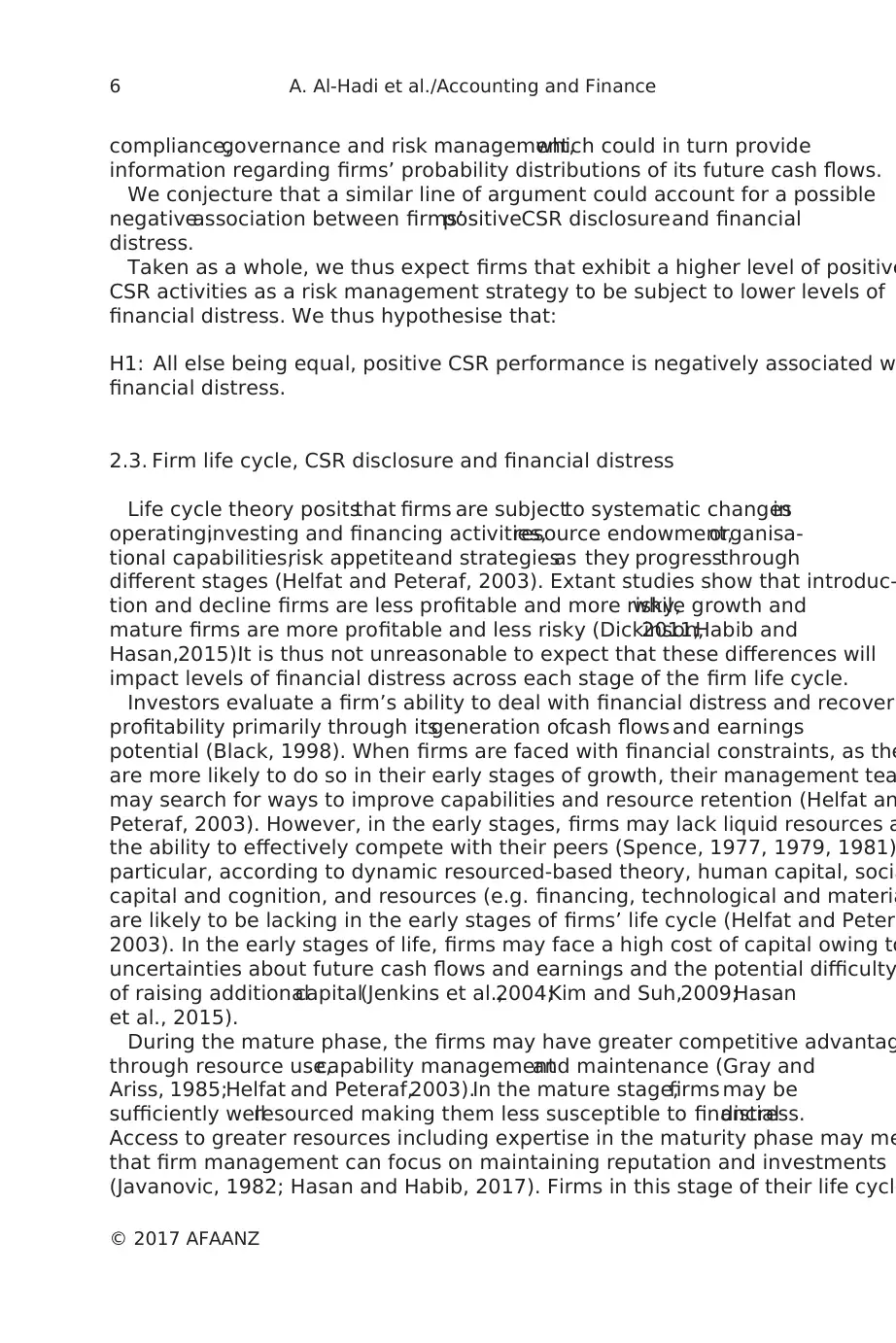
compliance,governance and risk management,which could in turn provide
information regarding firms’ probability distributions of its future cash flows.
We conjecture that a similar line of argument could account for a possible
negativeassociation between firms’positiveCSR disclosureand financial
distress.
Taken as a whole, we thus expect firms that exhibit a higher level of positive
CSR activities as a risk management strategy to be subject to lower levels of
financial distress. We thus hypothesise that:
H1: All else being equal, positive CSR performance is negatively associated w
financial distress.
2.3. Firm life cycle, CSR disclosure and financial distress
Life cycle theory positsthat firms are subjectto systematic changesin
operating,investing and financing activities,resource endowment,organisa-
tional capabilities,risk appetiteand strategiesas they progressthrough
different stages (Helfat and Peteraf, 2003). Extant studies show that introduc-
tion and decline firms are less profitable and more risky,while growth and
mature firms are more profitable and less risky (Dickinson,2011;Habib and
Hasan,2015).It is thus not unreasonable to expect that these differences will
impact levels of financial distress across each stage of the firm life cycle.
Investors evaluate a firm’s ability to deal with financial distress and recover
profitability primarily through itsgeneration ofcash flows and earnings
potential (Black, 1998). When firms are faced with financial constraints, as the
are more likely to do so in their early stages of growth, their management tea
may search for ways to improve capabilities and resource retention (Helfat an
Peteraf, 2003). However, in the early stages, firms may lack liquid resources a
the ability to effectively compete with their peers (Spence, 1977, 1979, 1981)
particular, according to dynamic resourced-based theory, human capital, socia
capital and cognition, and resources (e.g. financing, technological and materia
are likely to be lacking in the early stages of firms’ life cycle (Helfat and Petera
2003). In the early stages of life, firms may face a high cost of capital owing to
uncertainties about future cash flows and earnings and the potential difficulty
of raising additionalcapital(Jenkins et al.,2004;Kim and Suh,2009;Hasan
et al., 2015).
During the mature phase, the firms may have greater competitive advantag
through resource use,capability managementand maintenance (Gray and
Ariss, 1985;Helfat and Peteraf,2003).In the mature stage,firms may be
sufficiently wellresourced making them less susceptible to financialdistress.
Access to greater resources including expertise in the maturity phase may me
that firm management can focus on maintaining reputation and investments
(Javanovic, 1982; Hasan and Habib, 2017). Firms in this stage of their life cycle
© 2017 AFAANZ
6 A. Al-Hadi et al./Accounting and Finance
information regarding firms’ probability distributions of its future cash flows.
We conjecture that a similar line of argument could account for a possible
negativeassociation between firms’positiveCSR disclosureand financial
distress.
Taken as a whole, we thus expect firms that exhibit a higher level of positive
CSR activities as a risk management strategy to be subject to lower levels of
financial distress. We thus hypothesise that:
H1: All else being equal, positive CSR performance is negatively associated w
financial distress.
2.3. Firm life cycle, CSR disclosure and financial distress
Life cycle theory positsthat firms are subjectto systematic changesin
operating,investing and financing activities,resource endowment,organisa-
tional capabilities,risk appetiteand strategiesas they progressthrough
different stages (Helfat and Peteraf, 2003). Extant studies show that introduc-
tion and decline firms are less profitable and more risky,while growth and
mature firms are more profitable and less risky (Dickinson,2011;Habib and
Hasan,2015).It is thus not unreasonable to expect that these differences will
impact levels of financial distress across each stage of the firm life cycle.
Investors evaluate a firm’s ability to deal with financial distress and recover
profitability primarily through itsgeneration ofcash flows and earnings
potential (Black, 1998). When firms are faced with financial constraints, as the
are more likely to do so in their early stages of growth, their management tea
may search for ways to improve capabilities and resource retention (Helfat an
Peteraf, 2003). However, in the early stages, firms may lack liquid resources a
the ability to effectively compete with their peers (Spence, 1977, 1979, 1981)
particular, according to dynamic resourced-based theory, human capital, socia
capital and cognition, and resources (e.g. financing, technological and materia
are likely to be lacking in the early stages of firms’ life cycle (Helfat and Petera
2003). In the early stages of life, firms may face a high cost of capital owing to
uncertainties about future cash flows and earnings and the potential difficulty
of raising additionalcapital(Jenkins et al.,2004;Kim and Suh,2009;Hasan
et al., 2015).
During the mature phase, the firms may have greater competitive advantag
through resource use,capability managementand maintenance (Gray and
Ariss, 1985;Helfat and Peteraf,2003).In the mature stage,firms may be
sufficiently wellresourced making them less susceptible to financialdistress.
Access to greater resources including expertise in the maturity phase may me
that firm management can focus on maintaining reputation and investments
(Javanovic, 1982; Hasan and Habib, 2017). Firms in this stage of their life cycle
© 2017 AFAANZ
6 A. Al-Hadi et al./Accounting and Finance
Paraphrase This Document
Need a fresh take? Get an instant paraphrase of this document with our AI Paraphraser
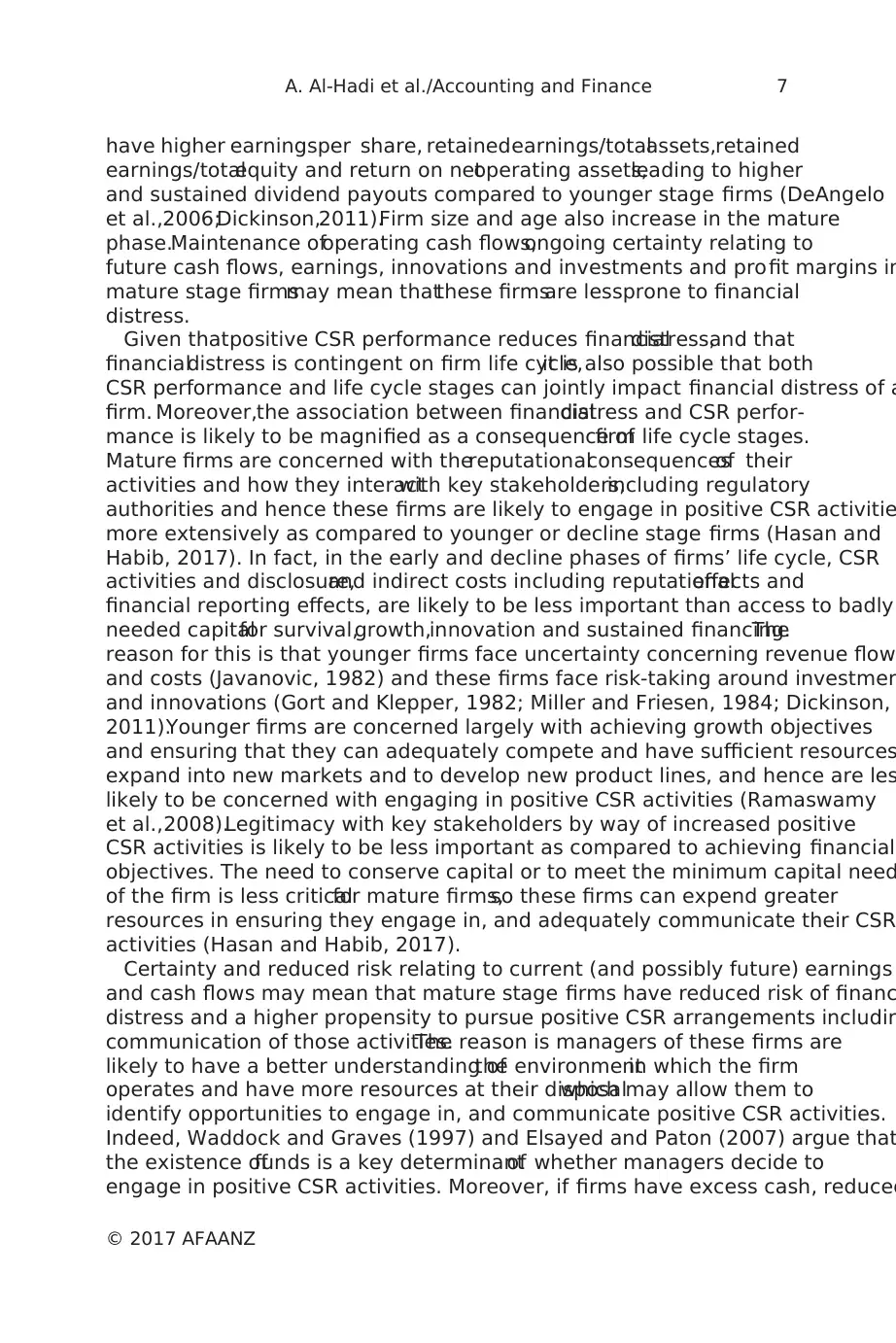
have higher earningsper share, retainedearnings/totalassets,retained
earnings/totalequity and return on netoperating assets,leading to higher
and sustained dividend payouts compared to younger stage firms (DeAngelo
et al.,2006;Dickinson,2011).Firm size and age also increase in the mature
phase.Maintenance ofoperating cash flows,ongoing certainty relating to
future cash flows, earnings, innovations and investments and profit margins in
mature stage firmsmay mean thatthese firmsare lessprone to financial
distress.
Given thatpositive CSR performance reduces financialdistress,and that
financialdistress is contingent on firm life cycle,it is also possible that both
CSR performance and life cycle stages can jointly impact financial distress of a
firm. Moreover,the association between financialdistress and CSR perfor-
mance is likely to be magnified as a consequence offirm life cycle stages.
Mature firms are concerned with thereputationalconsequencesof their
activities and how they interactwith key stakeholders,including regulatory
authorities and hence these firms are likely to engage in positive CSR activitie
more extensively as compared to younger or decline stage firms (Hasan and
Habib, 2017). In fact, in the early and decline phases of firms’ life cycle, CSR
activities and disclosure,and indirect costs including reputationaleffects and
financial reporting effects, are likely to be less important than access to badly
needed capitalfor survival,growth,innovation and sustained financing.The
reason for this is that younger firms face uncertainty concerning revenue flow
and costs (Javanovic, 1982) and these firms face risk-taking around investmen
and innovations (Gort and Klepper, 1982; Miller and Friesen, 1984; Dickinson,
2011).Younger firms are concerned largely with achieving growth objectives
and ensuring that they can adequately compete and have sufficient resources
expand into new markets and to develop new product lines, and hence are les
likely to be concerned with engaging in positive CSR activities (Ramaswamy
et al.,2008).Legitimacy with key stakeholders by way of increased positive
CSR activities is likely to be less important as compared to achieving financial
objectives. The need to conserve capital or to meet the minimum capital need
of the firm is less criticalfor mature firms,so these firms can expend greater
resources in ensuring they engage in, and adequately communicate their CSR
activities (Hasan and Habib, 2017).
Certainty and reduced risk relating to current (and possibly future) earnings
and cash flows may mean that mature stage firms have reduced risk of financ
distress and a higher propensity to pursue positive CSR arrangements includin
communication of those activities.The reason is managers of these firms are
likely to have a better understanding ofthe environmentin which the firm
operates and have more resources at their disposalwhich may allow them to
identify opportunities to engage in, and communicate positive CSR activities.
Indeed, Waddock and Graves (1997) and Elsayed and Paton (2007) argue that
the existence offunds is a key determinantof whether managers decide to
engage in positive CSR activities. Moreover, if firms have excess cash, reduced
© 2017 AFAANZ
A. Al-Hadi et al./Accounting and Finance 7
earnings/totalequity and return on netoperating assets,leading to higher
and sustained dividend payouts compared to younger stage firms (DeAngelo
et al.,2006;Dickinson,2011).Firm size and age also increase in the mature
phase.Maintenance ofoperating cash flows,ongoing certainty relating to
future cash flows, earnings, innovations and investments and profit margins in
mature stage firmsmay mean thatthese firmsare lessprone to financial
distress.
Given thatpositive CSR performance reduces financialdistress,and that
financialdistress is contingent on firm life cycle,it is also possible that both
CSR performance and life cycle stages can jointly impact financial distress of a
firm. Moreover,the association between financialdistress and CSR perfor-
mance is likely to be magnified as a consequence offirm life cycle stages.
Mature firms are concerned with thereputationalconsequencesof their
activities and how they interactwith key stakeholders,including regulatory
authorities and hence these firms are likely to engage in positive CSR activitie
more extensively as compared to younger or decline stage firms (Hasan and
Habib, 2017). In fact, in the early and decline phases of firms’ life cycle, CSR
activities and disclosure,and indirect costs including reputationaleffects and
financial reporting effects, are likely to be less important than access to badly
needed capitalfor survival,growth,innovation and sustained financing.The
reason for this is that younger firms face uncertainty concerning revenue flow
and costs (Javanovic, 1982) and these firms face risk-taking around investmen
and innovations (Gort and Klepper, 1982; Miller and Friesen, 1984; Dickinson,
2011).Younger firms are concerned largely with achieving growth objectives
and ensuring that they can adequately compete and have sufficient resources
expand into new markets and to develop new product lines, and hence are les
likely to be concerned with engaging in positive CSR activities (Ramaswamy
et al.,2008).Legitimacy with key stakeholders by way of increased positive
CSR activities is likely to be less important as compared to achieving financial
objectives. The need to conserve capital or to meet the minimum capital need
of the firm is less criticalfor mature firms,so these firms can expend greater
resources in ensuring they engage in, and adequately communicate their CSR
activities (Hasan and Habib, 2017).
Certainty and reduced risk relating to current (and possibly future) earnings
and cash flows may mean that mature stage firms have reduced risk of financ
distress and a higher propensity to pursue positive CSR arrangements includin
communication of those activities.The reason is managers of these firms are
likely to have a better understanding ofthe environmentin which the firm
operates and have more resources at their disposalwhich may allow them to
identify opportunities to engage in, and communicate positive CSR activities.
Indeed, Waddock and Graves (1997) and Elsayed and Paton (2007) argue that
the existence offunds is a key determinantof whether managers decide to
engage in positive CSR activities. Moreover, if firms have excess cash, reduced
© 2017 AFAANZ
A. Al-Hadi et al./Accounting and Finance 7
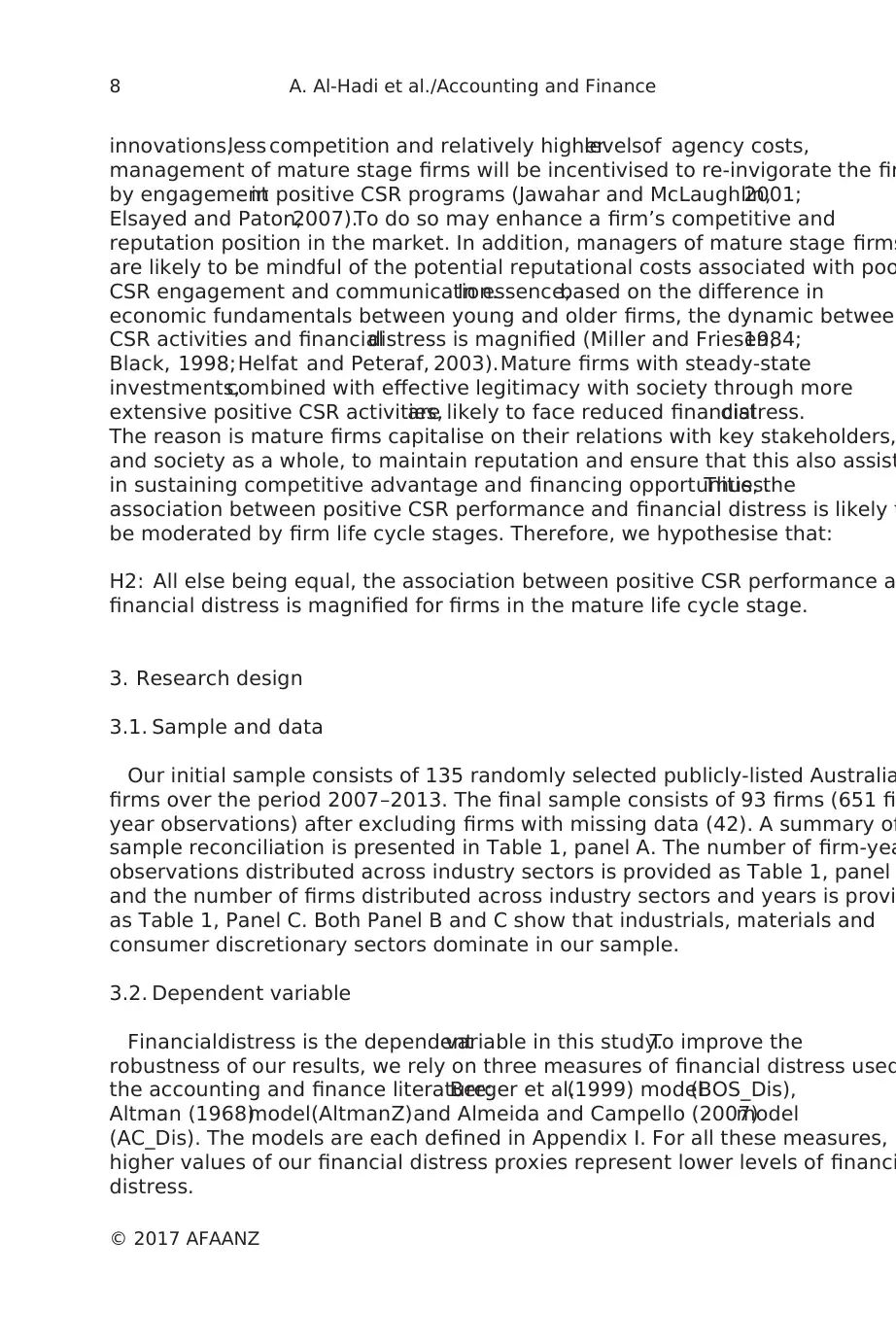
innovations,less competition and relatively higherlevelsof agency costs,
management of mature stage firms will be incentivised to re-invigorate the fir
by engagementin positive CSR programs (Jawahar and McLaughlin,2001;
Elsayed and Paton,2007).To do so may enhance a firm’s competitive and
reputation position in the market. In addition, managers of mature stage firms
are likely to be mindful of the potential reputational costs associated with poo
CSR engagement and communication.In essence,based on the difference in
economic fundamentals between young and older firms, the dynamic between
CSR activities and financialdistress is magnified (Miller and Friesen,1984;
Black, 1998;Helfat and Peteraf, 2003).Mature firms with steady-state
investments,combined with effective legitimacy with society through more
extensive positive CSR activities,are likely to face reduced financialdistress.
The reason is mature firms capitalise on their relations with key stakeholders,
and society as a whole, to maintain reputation and ensure that this also assist
in sustaining competitive advantage and financing opportunities.Thus, the
association between positive CSR performance and financial distress is likely t
be moderated by firm life cycle stages. Therefore, we hypothesise that:
H2: All else being equal, the association between positive CSR performance a
financial distress is magnified for firms in the mature life cycle stage.
3. Research design
3.1. Sample and data
Our initial sample consists of 135 randomly selected publicly-listed Australia
firms over the period 2007–2013. The final sample consists of 93 firms (651 fi
year observations) after excluding firms with missing data (42). A summary of
sample reconciliation is presented in Table 1, panel A. The number of firm-yea
observations distributed across industry sectors is provided as Table 1, panel
and the number of firms distributed across industry sectors and years is provi
as Table 1, Panel C. Both Panel B and C show that industrials, materials and
consumer discretionary sectors dominate in our sample.
3.2. Dependent variable
Financialdistress is the dependentvariable in this study.To improve the
robustness of our results, we rely on three measures of financial distress used
the accounting and finance literature:Berger et al.(1999) model(BOS_Dis),
Altman (1968)model(AltmanZ)and Almeida and Campello (2007)model
(AC_Dis). The models are each defined in Appendix I. For all these measures,
higher values of our financial distress proxies represent lower levels of financi
distress.
© 2017 AFAANZ
8 A. Al-Hadi et al./Accounting and Finance
management of mature stage firms will be incentivised to re-invigorate the fir
by engagementin positive CSR programs (Jawahar and McLaughlin,2001;
Elsayed and Paton,2007).To do so may enhance a firm’s competitive and
reputation position in the market. In addition, managers of mature stage firms
are likely to be mindful of the potential reputational costs associated with poo
CSR engagement and communication.In essence,based on the difference in
economic fundamentals between young and older firms, the dynamic between
CSR activities and financialdistress is magnified (Miller and Friesen,1984;
Black, 1998;Helfat and Peteraf, 2003).Mature firms with steady-state
investments,combined with effective legitimacy with society through more
extensive positive CSR activities,are likely to face reduced financialdistress.
The reason is mature firms capitalise on their relations with key stakeholders,
and society as a whole, to maintain reputation and ensure that this also assist
in sustaining competitive advantage and financing opportunities.Thus, the
association between positive CSR performance and financial distress is likely t
be moderated by firm life cycle stages. Therefore, we hypothesise that:
H2: All else being equal, the association between positive CSR performance a
financial distress is magnified for firms in the mature life cycle stage.
3. Research design
3.1. Sample and data
Our initial sample consists of 135 randomly selected publicly-listed Australia
firms over the period 2007–2013. The final sample consists of 93 firms (651 fi
year observations) after excluding firms with missing data (42). A summary of
sample reconciliation is presented in Table 1, panel A. The number of firm-yea
observations distributed across industry sectors is provided as Table 1, panel
and the number of firms distributed across industry sectors and years is provi
as Table 1, Panel C. Both Panel B and C show that industrials, materials and
consumer discretionary sectors dominate in our sample.
3.2. Dependent variable
Financialdistress is the dependentvariable in this study.To improve the
robustness of our results, we rely on three measures of financial distress used
the accounting and finance literature:Berger et al.(1999) model(BOS_Dis),
Altman (1968)model(AltmanZ)and Almeida and Campello (2007)model
(AC_Dis). The models are each defined in Appendix I. For all these measures,
higher values of our financial distress proxies represent lower levels of financi
distress.
© 2017 AFAANZ
8 A. Al-Hadi et al./Accounting and Finance
⊘ This is a preview!⊘
Do you want full access?
Subscribe today to unlock all pages.

Trusted by 1+ million students worldwide
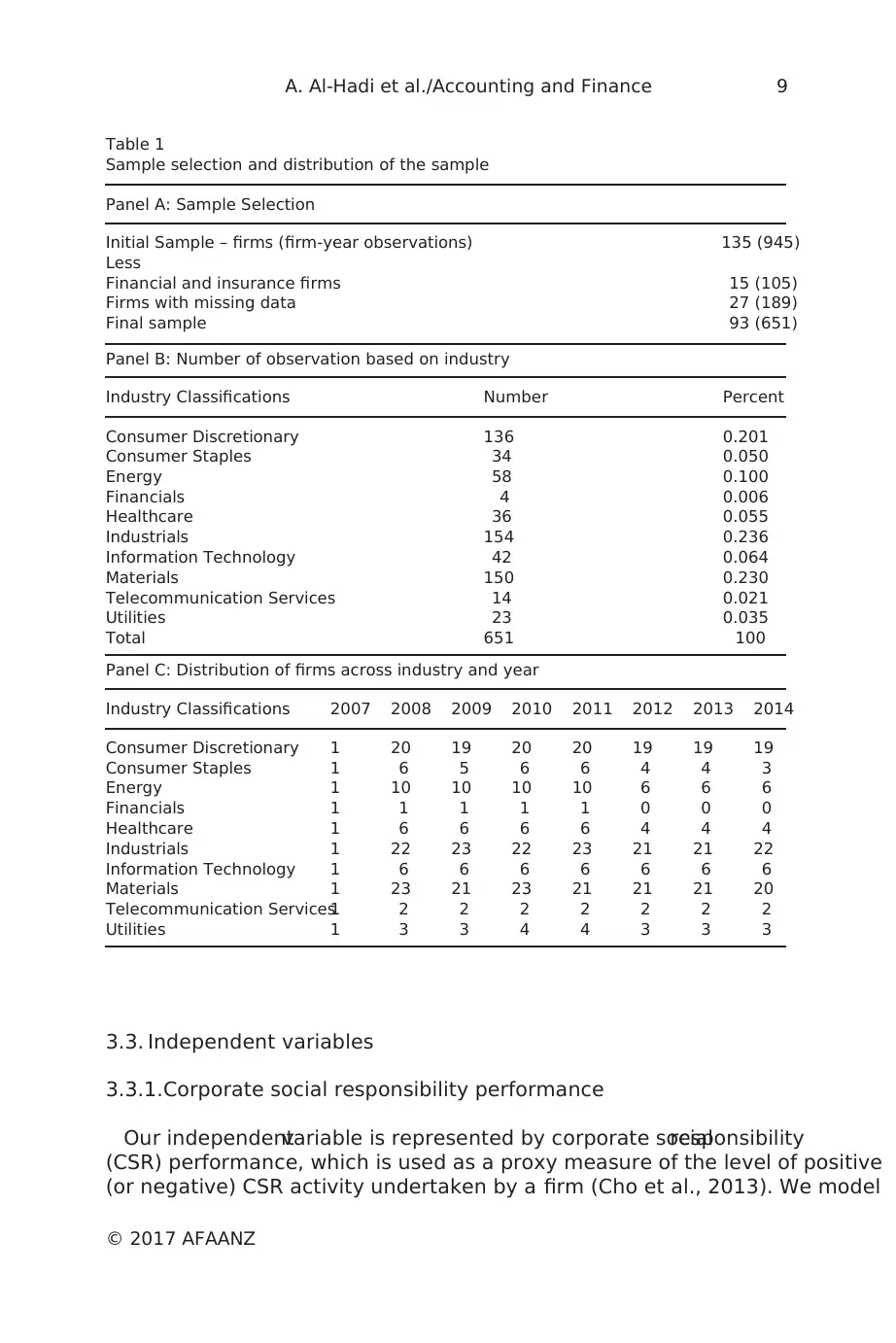
3.3. Independent variables
3.3.1.Corporate social responsibility performance
Our independentvariable is represented by corporate socialresponsibility
(CSR) performance, which is used as a proxy measure of the level of positive
(or negative) CSR activity undertaken by a firm (Cho et al., 2013). We model
Table 1
Sample selection and distribution of the sample
Panel A: Sample Selection
Initial Sample – firms (firm-year observations) 135 (945)
Less
Financial and insurance firms 15 (105)
Firms with missing data 27 (189)
Final sample 93 (651)
Panel B: Number of observation based on industry
Industry Classifications Number Percent
Consumer Discretionary 136 0.201
Consumer Staples 34 0.050
Energy 58 0.100
Financials 4 0.006
Healthcare 36 0.055
Industrials 154 0.236
Information Technology 42 0.064
Materials 150 0.230
Telecommunication Services 14 0.021
Utilities 23 0.035
Total 651 100
Panel C: Distribution of firms across industry and year
Industry Classifications 2007 2008 2009 2010 2011 2012 2013 2014
Consumer Discretionary 1 20 19 20 20 19 19 19
Consumer Staples 1 6 5 6 6 4 4 3
Energy 1 10 10 10 10 6 6 6
Financials 1 1 1 1 1 0 0 0
Healthcare 1 6 6 6 6 4 4 4
Industrials 1 22 23 22 23 21 21 22
Information Technology 1 6 6 6 6 6 6 6
Materials 1 23 21 23 21 21 21 20
Telecommunication Services1 2 2 2 2 2 2 2
Utilities 1 3 3 4 4 3 3 3
© 2017 AFAANZ
A. Al-Hadi et al./Accounting and Finance 9
3.3.1.Corporate social responsibility performance
Our independentvariable is represented by corporate socialresponsibility
(CSR) performance, which is used as a proxy measure of the level of positive
(or negative) CSR activity undertaken by a firm (Cho et al., 2013). We model
Table 1
Sample selection and distribution of the sample
Panel A: Sample Selection
Initial Sample – firms (firm-year observations) 135 (945)
Less
Financial and insurance firms 15 (105)
Firms with missing data 27 (189)
Final sample 93 (651)
Panel B: Number of observation based on industry
Industry Classifications Number Percent
Consumer Discretionary 136 0.201
Consumer Staples 34 0.050
Energy 58 0.100
Financials 4 0.006
Healthcare 36 0.055
Industrials 154 0.236
Information Technology 42 0.064
Materials 150 0.230
Telecommunication Services 14 0.021
Utilities 23 0.035
Total 651 100
Panel C: Distribution of firms across industry and year
Industry Classifications 2007 2008 2009 2010 2011 2012 2013 2014
Consumer Discretionary 1 20 19 20 20 19 19 19
Consumer Staples 1 6 5 6 6 4 4 3
Energy 1 10 10 10 10 6 6 6
Financials 1 1 1 1 1 0 0 0
Healthcare 1 6 6 6 6 4 4 4
Industrials 1 22 23 22 23 21 21 22
Information Technology 1 6 6 6 6 6 6 6
Materials 1 23 21 23 21 21 21 20
Telecommunication Services1 2 2 2 2 2 2 2
Utilities 1 3 3 4 4 3 3 3
© 2017 AFAANZ
A. Al-Hadi et al./Accounting and Finance 9
Paraphrase This Document
Need a fresh take? Get an instant paraphrase of this document with our AI Paraphraser
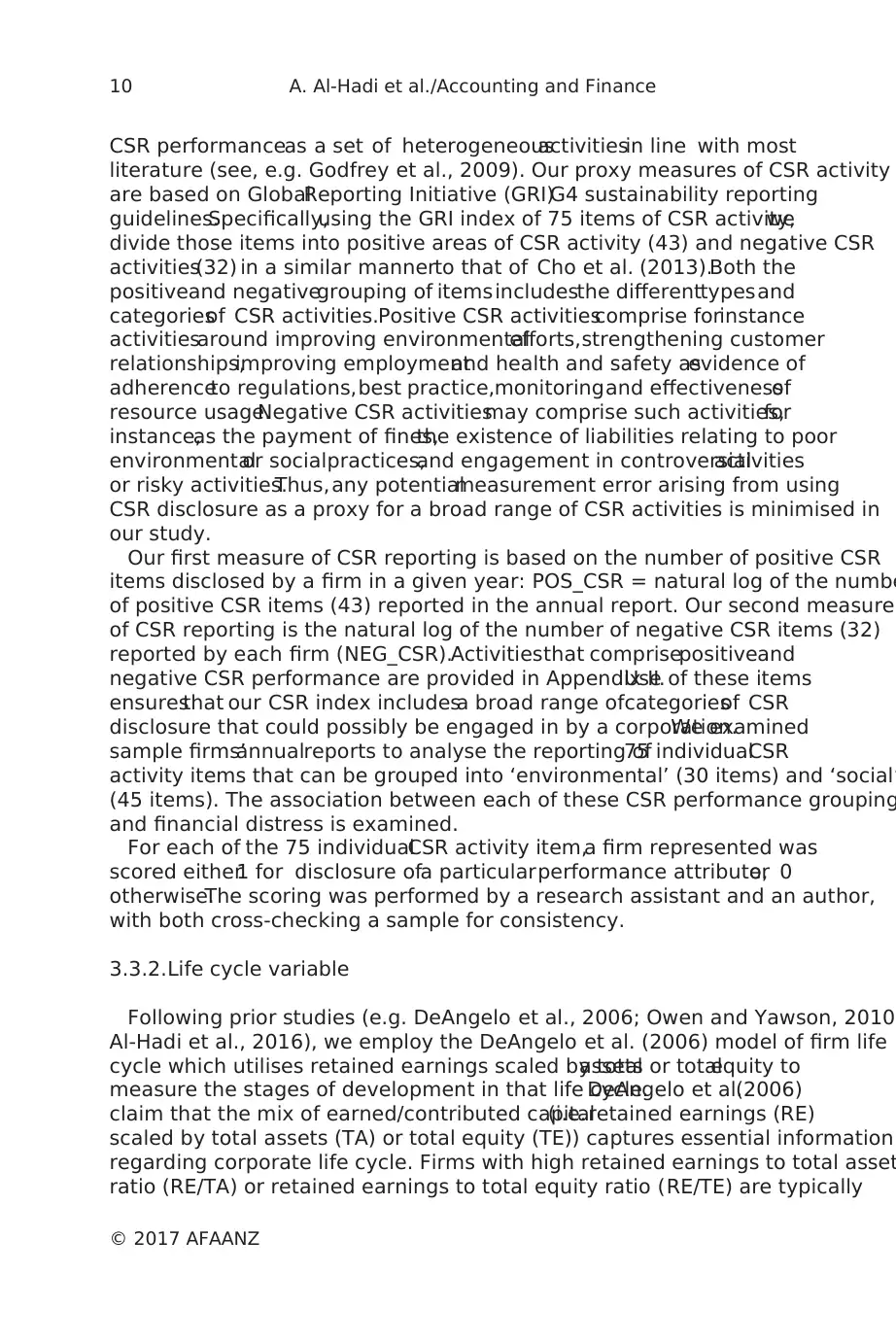
CSR performanceas a set of heterogeneousactivitiesin line with most
literature (see, e.g. Godfrey et al., 2009). Our proxy measures of CSR activity
are based on GlobalReporting Initiative (GRI)G4 sustainability reporting
guidelines.Specifically,using the GRI index of 75 items of CSR activity,we
divide those items into positive areas of CSR activity (43) and negative CSR
activities(32) in a similar mannerto that of Cho et al. (2013).Both the
positiveand negativegrouping of itemsincludesthe differenttypesand
categoriesof CSR activities.Positive CSR activitiescomprise forinstance
activitiesaround improving environmentalefforts,strengthening customer
relationships,improving employmentand health and safety asevidence of
adherenceto regulations,best practice,monitoringand effectivenessof
resource usage.Negative CSR activitiesmay comprise such activities,for
instance,as the payment of fines,the existence of liabilities relating to poor
environmentalor socialpractices,and engagement in controversialactivities
or risky activities.Thus,any potentialmeasurement error arising from using
CSR disclosure as a proxy for a broad range of CSR activities is minimised in
our study.
Our first measure of CSR reporting is based on the number of positive CSR
items disclosed by a firm in a given year: POS_CSR = natural log of the numbe
of positive CSR items (43) reported in the annual report. Our second measure
of CSR reporting is the natural log of the number of negative CSR items (32)
reported by each firm (NEG_CSR).Activitiesthat comprisepositiveand
negative CSR performance are provided in Appendix II.Use of these items
ensuresthat our CSR index includesa broad range ofcategoriesof CSR
disclosure that could possibly be engaged in by a corporation.We examined
sample firms’annualreports to analyse the reporting of75 individualCSR
activity items that can be grouped into ‘environmental’ (30 items) and ‘social’
(45 items). The association between each of these CSR performance grouping
and financial distress is examined.
For each of the 75 individualCSR activity item,a firm represented was
scored either1 for disclosure ofa particularperformance attribute,or 0
otherwise.The scoring was performed by a research assistant and an author,
with both cross-checking a sample for consistency.
3.3.2.Life cycle variable
Following prior studies (e.g. DeAngelo et al., 2006; Owen and Yawson, 2010
Al-Hadi et al., 2016), we employ the DeAngelo et al. (2006) model of firm life
cycle which utilises retained earnings scaled by totalassets or totalequity to
measure the stages of development in that life cycle.DeAngelo et al.(2006)
claim that the mix of earned/contributed capital(i.e.retained earnings (RE)
scaled by total assets (TA) or total equity (TE)) captures essential information
regarding corporate life cycle. Firms with high retained earnings to total asset
ratio (RE/TA) or retained earnings to total equity ratio (RE/TE) are typically
© 2017 AFAANZ
10 A. Al-Hadi et al./Accounting and Finance
literature (see, e.g. Godfrey et al., 2009). Our proxy measures of CSR activity
are based on GlobalReporting Initiative (GRI)G4 sustainability reporting
guidelines.Specifically,using the GRI index of 75 items of CSR activity,we
divide those items into positive areas of CSR activity (43) and negative CSR
activities(32) in a similar mannerto that of Cho et al. (2013).Both the
positiveand negativegrouping of itemsincludesthe differenttypesand
categoriesof CSR activities.Positive CSR activitiescomprise forinstance
activitiesaround improving environmentalefforts,strengthening customer
relationships,improving employmentand health and safety asevidence of
adherenceto regulations,best practice,monitoringand effectivenessof
resource usage.Negative CSR activitiesmay comprise such activities,for
instance,as the payment of fines,the existence of liabilities relating to poor
environmentalor socialpractices,and engagement in controversialactivities
or risky activities.Thus,any potentialmeasurement error arising from using
CSR disclosure as a proxy for a broad range of CSR activities is minimised in
our study.
Our first measure of CSR reporting is based on the number of positive CSR
items disclosed by a firm in a given year: POS_CSR = natural log of the numbe
of positive CSR items (43) reported in the annual report. Our second measure
of CSR reporting is the natural log of the number of negative CSR items (32)
reported by each firm (NEG_CSR).Activitiesthat comprisepositiveand
negative CSR performance are provided in Appendix II.Use of these items
ensuresthat our CSR index includesa broad range ofcategoriesof CSR
disclosure that could possibly be engaged in by a corporation.We examined
sample firms’annualreports to analyse the reporting of75 individualCSR
activity items that can be grouped into ‘environmental’ (30 items) and ‘social’
(45 items). The association between each of these CSR performance grouping
and financial distress is examined.
For each of the 75 individualCSR activity item,a firm represented was
scored either1 for disclosure ofa particularperformance attribute,or 0
otherwise.The scoring was performed by a research assistant and an author,
with both cross-checking a sample for consistency.
3.3.2.Life cycle variable
Following prior studies (e.g. DeAngelo et al., 2006; Owen and Yawson, 2010
Al-Hadi et al., 2016), we employ the DeAngelo et al. (2006) model of firm life
cycle which utilises retained earnings scaled by totalassets or totalequity to
measure the stages of development in that life cycle.DeAngelo et al.(2006)
claim that the mix of earned/contributed capital(i.e.retained earnings (RE)
scaled by total assets (TA) or total equity (TE)) captures essential information
regarding corporate life cycle. Firms with high retained earnings to total asset
ratio (RE/TA) or retained earnings to total equity ratio (RE/TE) are typically
© 2017 AFAANZ
10 A. Al-Hadi et al./Accounting and Finance
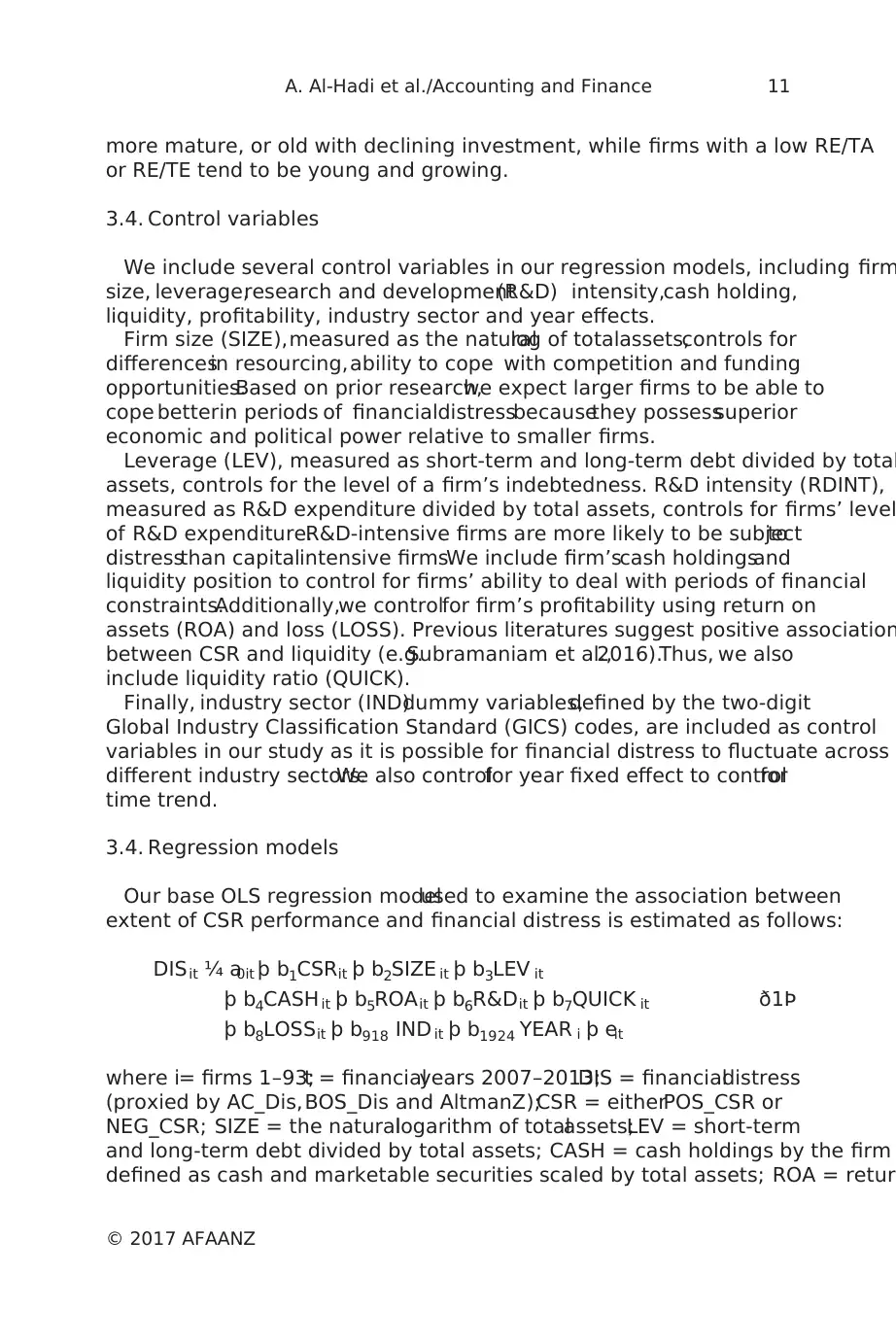
more mature, or old with declining investment, while firms with a low RE/TA
or RE/TE tend to be young and growing.
3.4. Control variables
We include several control variables in our regression models, including firm
size, leverage,research and development(R&D) intensity,cash holding,
liquidity, profitability, industry sector and year effects.
Firm size (SIZE),measured as the naturallog of totalassets,controls for
differencesin resourcing,ability to cope with competition and funding
opportunities.Based on prior research,we expect larger firms to be able to
cope betterin periods of financialdistressbecausethey possesssuperior
economic and political power relative to smaller firms.
Leverage (LEV), measured as short-term and long-term debt divided by total
assets, controls for the level of a firm’s indebtedness. R&D intensity (RDINT),
measured as R&D expenditure divided by total assets, controls for firms’ level
of R&D expenditure.R&D-intensive firms are more likely to be subjectto
distressthan capitalintensive firms.We include firm’scash holdingsand
liquidity position to control for firms’ ability to deal with periods of financial
constraints.Additionally,we controlfor firm’s profitability using return on
assets (ROA) and loss (LOSS). Previous literatures suggest positive association
between CSR and liquidity (e.g.Subramaniam et al.,2016).Thus, we also
include liquidity ratio (QUICK).
Finally, industry sector (IND)dummy variables,defined by the two-digit
Global Industry Classification Standard (GICS) codes, are included as control
variables in our study as it is possible for financial distress to fluctuate across
different industry sectors.We also controlfor year fixed effect to controlfor
time trend.
3.4. Regression models
Our base OLS regression modelused to examine the association between
extent of CSR performance and financial distress is estimated as follows:
DISit ¼ a0it þ b1CSRit þ b2SIZE it þ b3LEV it
þ b4CASH it þ b5ROAit þ b6R&Dit þ b7QUICK it
þ b8LOSSit þ b918 IND it þ b1924 YEAR i þ eit
ð1Þ
where i= firms 1–93;t = financialyears 2007–2013;DIS = financialdistress
(proxied by AC_Dis,BOS_Dis and AltmanZ);CSR = eitherPOS_CSR or
NEG_CSR; SIZE = the naturallogarithm of totalassets;LEV = short-term
and long-term debt divided by total assets; CASH = cash holdings by the firm
defined as cash and marketable securities scaled by total assets; ROA = retur
© 2017 AFAANZ
A. Al-Hadi et al./Accounting and Finance 11
or RE/TE tend to be young and growing.
3.4. Control variables
We include several control variables in our regression models, including firm
size, leverage,research and development(R&D) intensity,cash holding,
liquidity, profitability, industry sector and year effects.
Firm size (SIZE),measured as the naturallog of totalassets,controls for
differencesin resourcing,ability to cope with competition and funding
opportunities.Based on prior research,we expect larger firms to be able to
cope betterin periods of financialdistressbecausethey possesssuperior
economic and political power relative to smaller firms.
Leverage (LEV), measured as short-term and long-term debt divided by total
assets, controls for the level of a firm’s indebtedness. R&D intensity (RDINT),
measured as R&D expenditure divided by total assets, controls for firms’ level
of R&D expenditure.R&D-intensive firms are more likely to be subjectto
distressthan capitalintensive firms.We include firm’scash holdingsand
liquidity position to control for firms’ ability to deal with periods of financial
constraints.Additionally,we controlfor firm’s profitability using return on
assets (ROA) and loss (LOSS). Previous literatures suggest positive association
between CSR and liquidity (e.g.Subramaniam et al.,2016).Thus, we also
include liquidity ratio (QUICK).
Finally, industry sector (IND)dummy variables,defined by the two-digit
Global Industry Classification Standard (GICS) codes, are included as control
variables in our study as it is possible for financial distress to fluctuate across
different industry sectors.We also controlfor year fixed effect to controlfor
time trend.
3.4. Regression models
Our base OLS regression modelused to examine the association between
extent of CSR performance and financial distress is estimated as follows:
DISit ¼ a0it þ b1CSRit þ b2SIZE it þ b3LEV it
þ b4CASH it þ b5ROAit þ b6R&Dit þ b7QUICK it
þ b8LOSSit þ b918 IND it þ b1924 YEAR i þ eit
ð1Þ
where i= firms 1–93;t = financialyears 2007–2013;DIS = financialdistress
(proxied by AC_Dis,BOS_Dis and AltmanZ);CSR = eitherPOS_CSR or
NEG_CSR; SIZE = the naturallogarithm of totalassets;LEV = short-term
and long-term debt divided by total assets; CASH = cash holdings by the firm
defined as cash and marketable securities scaled by total assets; ROA = retur
© 2017 AFAANZ
A. Al-Hadi et al./Accounting and Finance 11
⊘ This is a preview!⊘
Do you want full access?
Subscribe today to unlock all pages.

Trusted by 1+ million students worldwide
1 out of 30
Your All-in-One AI-Powered Toolkit for Academic Success.
+13062052269
info@desklib.com
Available 24*7 on WhatsApp / Email
![[object Object]](/_next/static/media/star-bottom.7253800d.svg)
Unlock your academic potential
Copyright © 2020–2025 A2Z Services. All Rights Reserved. Developed and managed by ZUCOL.